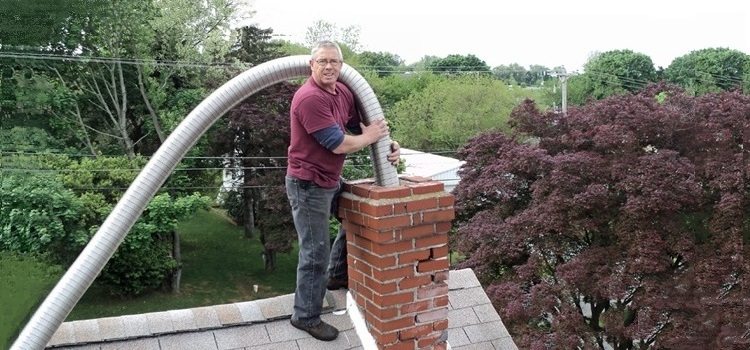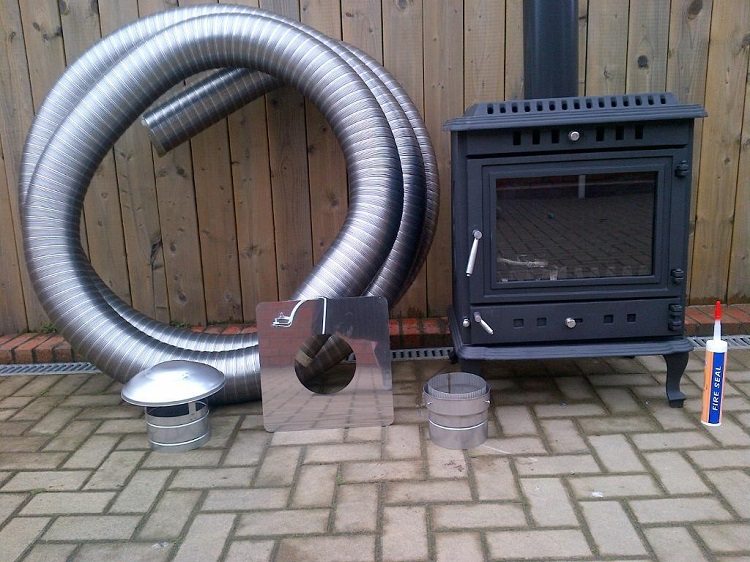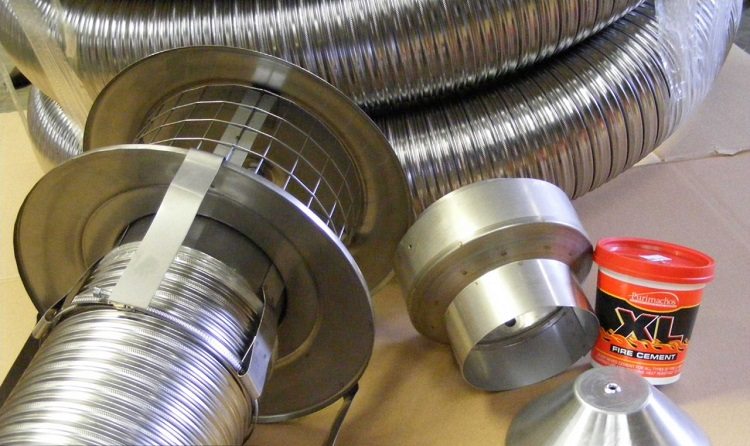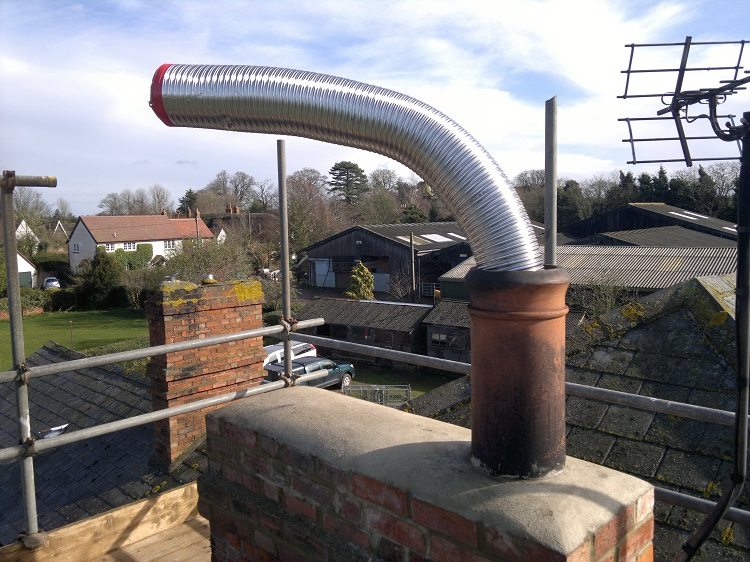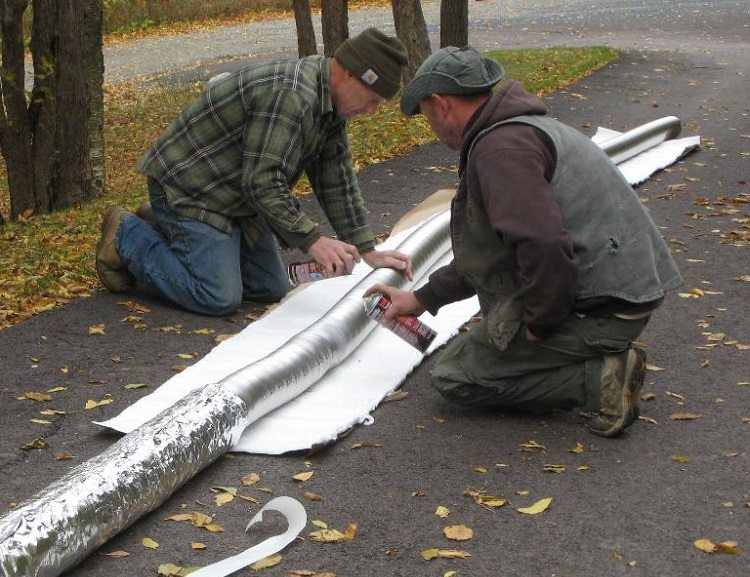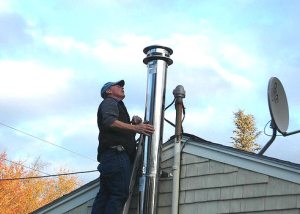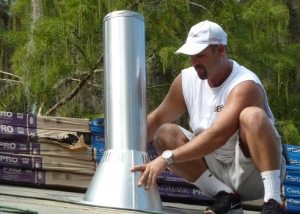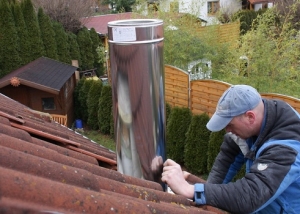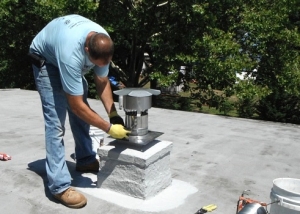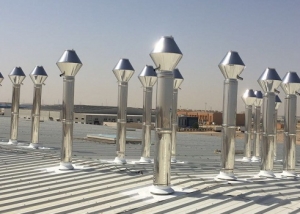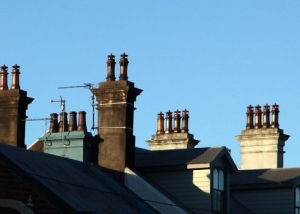Designing and installing a chimney for gas equipment is a complex and responsible process. In addition, the cost of such a design often goes too high due to the need to purchase a large number of connecting and fastening devices: fittings, clamps, brackets. A gas pipe made of inflexible material may require changes in the design of floors and roofs, which is also quite a costly undertaking. The use of a flexible chimney for a gas boiler is a low-cost alternative, but no less effective.
Content
Can a chimney corrugated gas pipe be used?
Chimney for stove or boiler, in fact, is a very vulnerable part of the design. Due to constant temperature fluctuations and the presence of toxic substances in the fuel processing products, there is a high probability of destruction of the chimney walls. Brick systems are particularly prone to this phenomenon. The only way out is the installation of steel chimneys, more durable and easier to install.
There are no obstacles to installing corrugated flexible products as a chimney for gas. With proper installation and operation, such systems can function no worse than smooth steel or asbestos-cement pipes.
Corrugated pipe differs in durability which is reached thanks to the following design features:
- its body looks like a cylindrical tube twisted in a spiral. Spiral strips are firmly connected by means of a lock seam;
- reinforcing wire creates a body - the basis for the pipe, protecting it from mechanical damage and shock. At the same time, the flexibility of the metal pipe does not decrease.
Good to know! The possibility of using a corrugated stainless steel pipe for gas is also mentioned in regulatory documents SP 42-101-2003, as well as in DBN V 2.5-20-2001 in force in Ukraine.
Corrugated chimney pipe for a gas boiler: options
There are several varieties of flexible corrugations that can be used as chimneys:
1. Stainless Steel Flexible Chimneys. The most acceptable option in terms of price and quality for connecting to high-temperature equipment. With proper installation and sufficient sealing, such chimneys are able to withstand the temperature of the exhaust gases, reaching 400 degrees. Besides, steel chimney can be used with some solid fuel boilers.
Corrugated stainless steel pipe is characterized by the following qualities:
- for steel flexible chimneys, sheet steel is used, the thickness of which will be from 0.12 mm to 1 mm;
- corrugated pipe has a high ability not only to bend, but also to compress and stretch; manual bending is possible, without the use of additional tools. In this case, the shape given to the corrugation will remain for a long time, and the diameter of the cross section will not change.
- resistance to high temperatures, temperature differences and exposure to aggressive acidic environments. This property is provided by stainless steel products with a significant concentration of alloying elements (nickel - about 14%, silicon - about 18%). Also, no acid residue will remain on the inner wall of the corrugated pipe.
- due to the thinness of the steel walls, the heating of the channel is carried out quickly and evenly. And subject to use insulation materials for insulation chimney heat loss will be minimal.
- flexibility without loss of integrity: it is possible to install without a large number of fittings, angles (rotary elbows), adapters and adapters.
2. Flexible chimney for a gas boiler made of aluminum. The design of this type of corrugated pipes completely coincides with the device of stainless steel products. The difference lies in the fact that aluminum is inferior to stainless steel in the ability to withstand high temperature loads, it is less durable and impact resistant.
Important! Corrugated aluminum pipe is not able to withstand temperatures above 500 degrees - its walls can melt and collapse, and particles of soot and other gas combustion products will enter the living room. But if the power of your gas boiler is low, then the aluminum pipe is quite suitable for operation.
Technical standards do not prescribe a ban on the use of aluminum pipes in the installation of chimney systems. But in in some regions of the Russian Federation there is an unofficial ban on the use of pipelines made of aluminum for gas equipment. therefore When checking your system or registering the boiler, the inspector may recommend that you replace the aluminum sleeve with pipes made of stronger material.
The use of a flexible stainless steel chimney
Corrugated steel sheet products can be used in the construction of high-temperature systems (as noted above, the temperature should not exceed 400 degrees). For kitchen geysers, the use of flexible chimneys is justified, since the temperature of the gases at the outlet drops to 200-300 degrees (at a temperature in the boiler reaching 1000-1200 degrees).
Corrugated stainless steel pipes are also used in the installation and repair work of existing chimneys. They perfectly perform the function of an adapter (adapter) in systems of smooth-walled pipes.
A stainless steel gas corrugated pipe is also used as a gas supply for household appliances. For such designs, brass or stainless fittings with a dielectric lining are used. There are similar pipes with a polyethylene coating on sale (traditionally yellow marking is used for gas pipes). Corrugated products for gas pipelines are available in small diameters, mainly 15 mm or 20 mm.
Flexible chimney: basic installation requirements
The quality and durability of consumables do not matter if the gas equipment was connected correctly. Mounting corrugated flues is a simpler operation than installing sandwich pipes for boilers, but also there are some nuances that must be taken into account when conducting work.
1. The selection of the diameter of the corrugated pipe. The chimney is connected to the inlet pipe of a gas boiler or furnace. In the reliability of the connection, the correctly selected diameter of the stainless steel pipe and a special adapter for fastening play an important role. If the boiler power is less than 19 kW, the diameter of the corrugated sleeve should be 110 mm. For a heating boiler with a higher power, it is preferable to use pipes with a diameter of 130 mm.
Important! At the point of connection of the chimney to the boiler, a vertical section with a length of not less than 500 mm is mandatory.
2. Optimal design of an exhaust system for gas. For maintaining a stable level of traction, the extent of the system sections parallel to the horizontal plane is responsible. An undesirable option is when the length of the horizontal sections is more than 3 meters. Also, professional builders do not recommend mounting more than 3 turns of sleeves in the design of a flexible chimney.
When creating a smoke exhaust system from a gas column, the corrugated pipe cannot be lifted straight up. You must either create a bend pipesor organize a condensate collector in front of the geyser.
3. Providing and checking for leaks at the joints. It is theoretically possible the passage of smoke at the joints of several pipes. To prevent leakage, the pipe blocks do not fix butt-to-butt, but place the end of one section in another. The tightness of such a connection is achieved with the help of adapters, on top of which, for better strength, a steel clamp is applied. It is forbidden to use metal tape for such purposes. The joints of several pipes cannot be located in the place of wall ceilings.
4. Insulation of the chimney. Any corrugated pipe, like smooth steel products, requires insulation. For these purposes, heat-resistant fibrous insulation is suitable. Its use reduces the amount of heat passing through the thin walls of the corrugated pipe and reduces the formation of condensate.
5. Organization of the passage flexible pipe through the roof. The place where the junction of the chimney with the roof passes requires special organization: it is equipped with a special refractory adapter.
For the installation of chimneys, both smooth rigid and corrugated steel pipe are suitable: in any case, the degree of safety during operation determines the accuracy of the installation. In terms of durability, smooth-walled structures will have more advantages. Corrugated flexible products are cheaper, mobile and lightweight, which is why they are popular.
